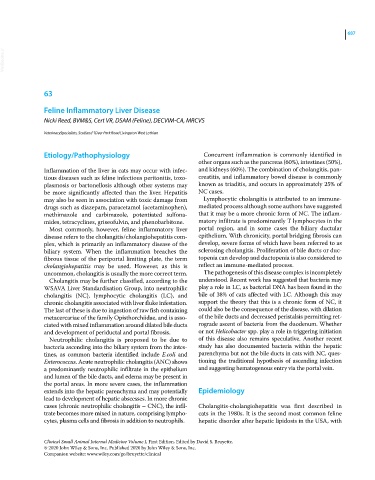Page 719 - Clinical Small Animal Internal Medicine
P. 719
687
VetBooks.ir
63
Feline Inflammatory Liver Disease
Nicki Reed, BVM&S, Cert VR, DSAM (Feline), DECVIM-CA, MRCVS
VeterinarySpecialists, Scotland 1Deer Park Road Livingston West Lothian
Etiology/Pathophysiology Concurrent inflammation is commonly identified in
other organs such as the pancreas (60%), intestines (50%),
Inflammation of the liver in cats may occur with infec- and kidneys (60%). The combination of cholangitis, pan-
tious diseases such as feline infectious peritonitis, toxo- creatitis, and inflammatory bowel disease is commonly
plasmosis or bartonellosis although other systems may known as triaditis, and occurs in approximately 25% of
be more significantly affected than the liver. Hepatitis NC cases.
may also be seen in association with toxic damage from Lymphocytic cholangitis is attributed to an immune‐
drugs such as diazepam, paracetamol (acetaminophen), mediated process although some authors have suggested
methimazole and carbimazole, potentiated sulfona- that it may be a more chronic form of NC. The inflam-
mides, tetracyclines, griseofulvin, and phenobarbitone. matory infiltrate is predominantly T lymphocytes in the
Most commonly, however, feline inflammatory liver portal region, and in some cases the biliary ductular
disease refers to the cholangitis/cholangiohepatitis com- epithelium. With chronicity, portal bridging fibrosis can
plex, which is primarily an inflammatory disease of the develop, severe forms of which have been referred to as
biliary system. When the inflammation breaches the sclerosing cholangitis. Proliferation of bile ducts or duc-
fibrous tissue of the periportal limiting plate, the term topenia can develop and ductopenia is also considered to
cholangiohepatitis may be used. However, as this is reflect an immune‐mediated process.
uncommon, cholangitis is usually the more correct term. The pathogenesis of this disease complex is incompletely
Cholangitis may be further classified, according to the understood. Recent work has suggested that bacteria may
WSAVA Liver Standardisation Group, into neutrophilic play a role in LC, as bacterial DNA has been found in the
cholangitis (NC), lymphocytic cholangitis (LC), and bile of 38% of cats affected with LC. Although this may
chronic cholangitis associated with liver fluke infestation. support the theory that this is a chronic form of NC, it
The last of these is due to ingestion of raw fish containing could also be the consequence of the disease, with dilation
metacercariae of the family Opisthorchiidae, and is asso- of the bile ducts and decreased peristalsis permitting ret-
ciated with mixed inflammation around dilated bile ducts rograde ascent of bacteria from the duodenum. Whether
and development of periductal and portal fibrosis. or not Helicobacter spp. play a role in triggering initiation
Neutrophilic cholangitis is proposed to be due to of this disease also remains speculative. Another recent
bacteria ascending into the biliary system from the intes- study has also documented bacteria within the hepatic
tines, as common bacteria identified include E.coli and parenchyma but not the bile ducts in cats with NC, ques-
Enterococcus. Acute neutrophilic cholangitis (ANC) shows tioning the traditional hypothesis of ascending infection
a predominantly neutrophilic infiltrate in the epithelium and suggesting hematogenous entry via the portal vein.
and lumen of the bile ducts, and edema may be present in
the portal areas. In more severe cases, the inflammation
extends into the hepatic parenchyma and may potentially Epidemiology
lead to development of hepatic abscesses. In more chronic
cases (chronic neutrophilic cholangitis – CNC), the infil- Cholangitis‐cholangiohepatitis was first described in
trate becomes more mixed in nature, comprising lympho- cats in the 1980s. It is the second most common feline
cytes, plasma cells and fibrosis in addition to neutrophils. hepatic disorder after hepatic lipidosis in the USA, with
Clinical Small Animal Internal Medicine Volume I, First Edition. Edited by David S. Bruyette.
© 2020 John Wiley & Sons, Inc. Published 2020 by John Wiley & Sons, Inc.
Companion website: www.wiley.com/go/bruyette/clinical

